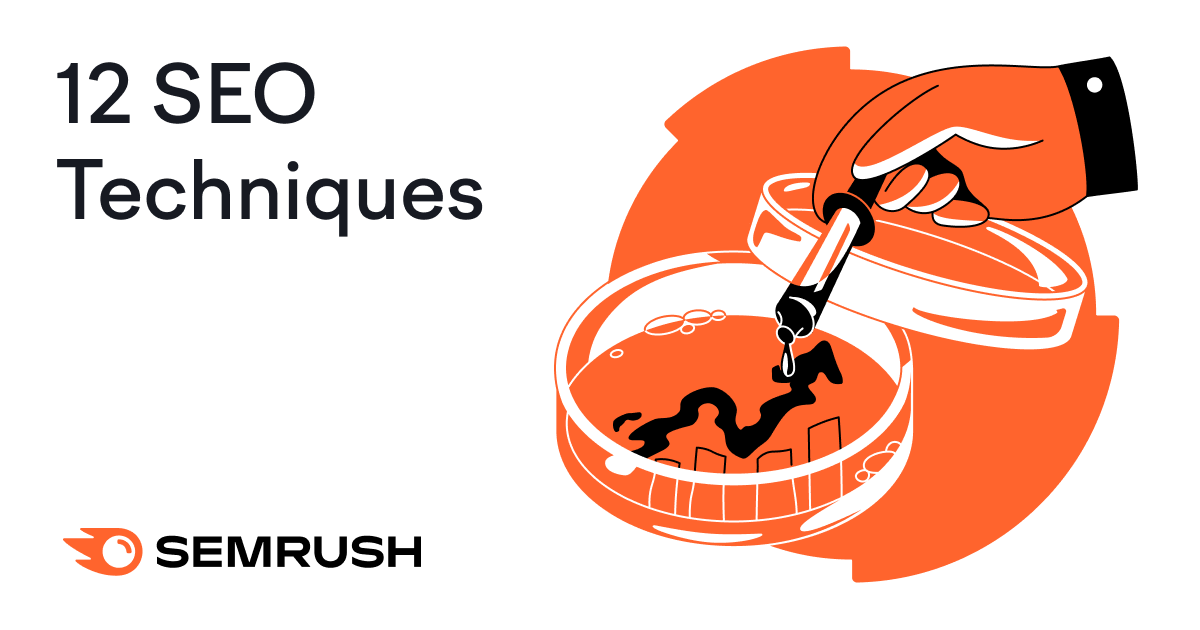Once you’ve understood the basics of what SEO is, you may be looking for some additional SEO techniques to help take your site’s organic traffic to the next level in 2022. When you first launch a site (or have just started to learn SEO), there’s a whole host of basics that you need to have in place. Things like:
- Keyword research
- Optimizing title tags and meta tags
- Creating optimized content
But what exactly comes next? Perhaps you’re not quite ready to dive deep into advanced SEO tactics, but you need to drive significant growth in organic visibility and resultant traffic? In this guide, we’re going to share 12 SEO techniques that can help you to supercharge your site’s performance and walk you step-by-step on how to execute each one of these.
12 SEO Techniques You Need To Be Using in 2021
Below are the SEO techniques that you should be paying attention to in order to increase your site’s organic traffic in 2022. You won’t just find on-page SEO tactics here, but off-page ones as well. By working to implement each of these, you’ll be able to work on improving your visibility and traffic.
Let’s get started.
1. Find Your Competitors’ Best Performing Pages
The more you know about your competitors’ SEO strategy, the better your own site can perform.
When you take the time to figure out what’s working for the websites you compete against on the SERPs, you can take your analysis to the next level and understand why this approach is working before using this insight to inform your own approach.
One effective starting point is to find your competitors’ best-performing pages so that you can develop a picture of where their organic traffic is coming from, and what it’s being driven by. Analyzing your competitors’ top pages can point you in the direction of things like
How do you find your competitors’ best pages? You can use Semrush’s Organic Research tool and enter the URL of a competitor.

This will show you the site’s estimated organic traffic and a general overview of performance, but you want to dive deeper here.
Open the ‘Pages’ tab on this screen and sort by traffic, and you’ll see which pages are organically performing on this domain.
.png)
This is simply a way to find out the pages that are driving the most traffic to competing websites. You’ll need to take this insight to the next level to figure out why these pages perform and how you can form a strategy that steals some of this traffic.
Think of this as an opportunity analysis or a shortcut to figuring out where your biggest wins could be based upon competitor activity, rather than starting with keyword research.
This works because it helps you to determine potential areas to focus your efforts on at a page-level, rather than at a specific keyword-level. This exercise can also help you to find other websites that compete against your own, too, that you perhaps hadn’t considered to be a competitor.
Head to the Competitors tab on the same tool and you’ll see a list of competing domains, as well as insights into the number of common keywords and estimated traffic
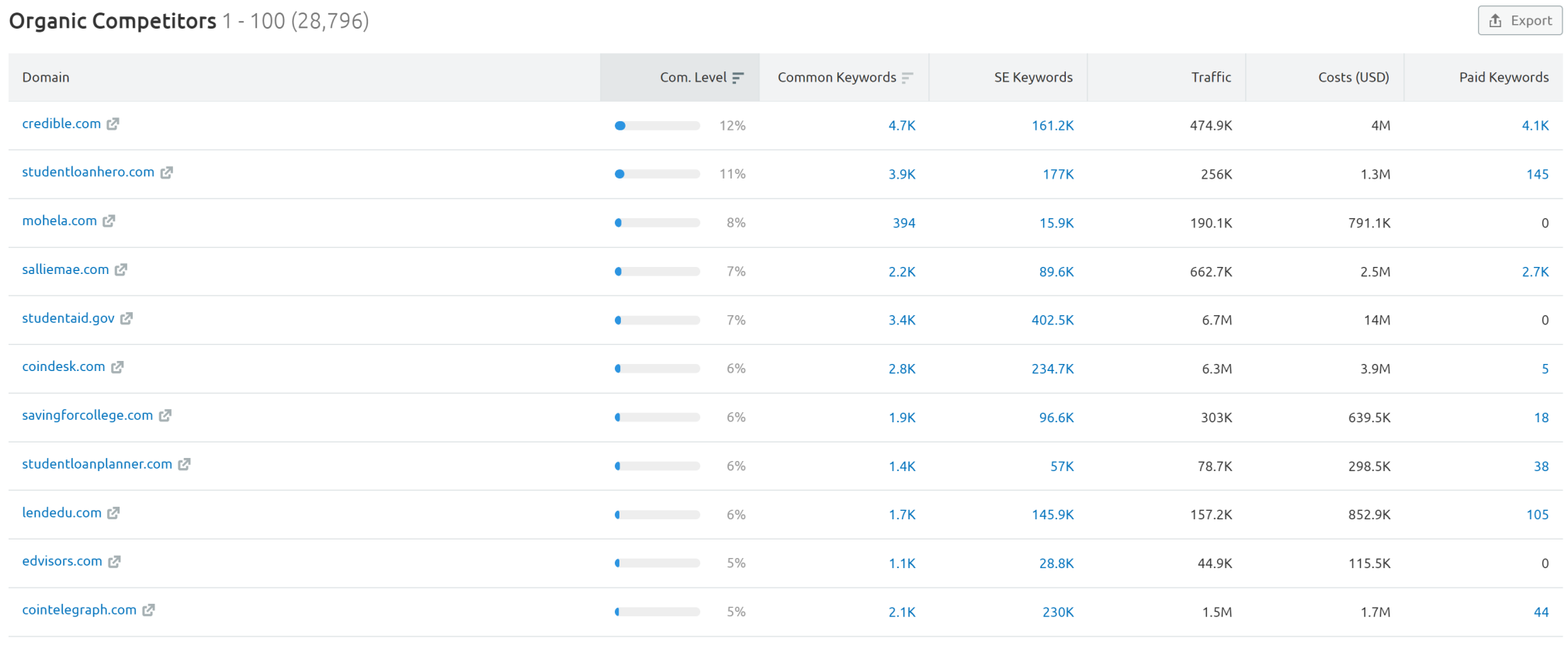
You can then analyze these domains individually using the tool to build up a detailed level of insight into the pages that perform the best in your industry.
2. Inform Your Content Strategy Using A Keyword Gap Analysis
When it comes to creating a content strategy, you will typically have two main focus areas:
- Optimizing existing content
- Creating new content
While optimizing existing content is often the most effective starting point (after all, it’s easier to see gains from improving content that is already indexed than completely new pieces), most websites will get to a stage where they’ve optimized all of their existing pieces.
At this point, your efforts should turn to the creation of new content. But one of the biggest mistakes that SEOs make when creating content is doing so blindly.
You need to be creating content with a purpose and need to be able to justify why every single piece that you create exists. This means taking the time to carefully plan out a strategy for the creation of new content.
One of the quickest ways to steer your content plan is to conduct a keyword gap analysis that will help you to see the keywords that your competitors rank for but that you don’t. From there, you can create content around these keywords and topics to fill the gap. And you can do it faster and more efficiently with dedicated SEO tools.
Head to the Semruh Keyword Gap tool and enter your own domain alongside up to four competitors’. Ensure that ‘Organic keywords’ is selected.

Hit ‘Compare’ and you’ll see a detailed insight into keyword opportunities. But we particularly want to pay attention to the comparison grid.
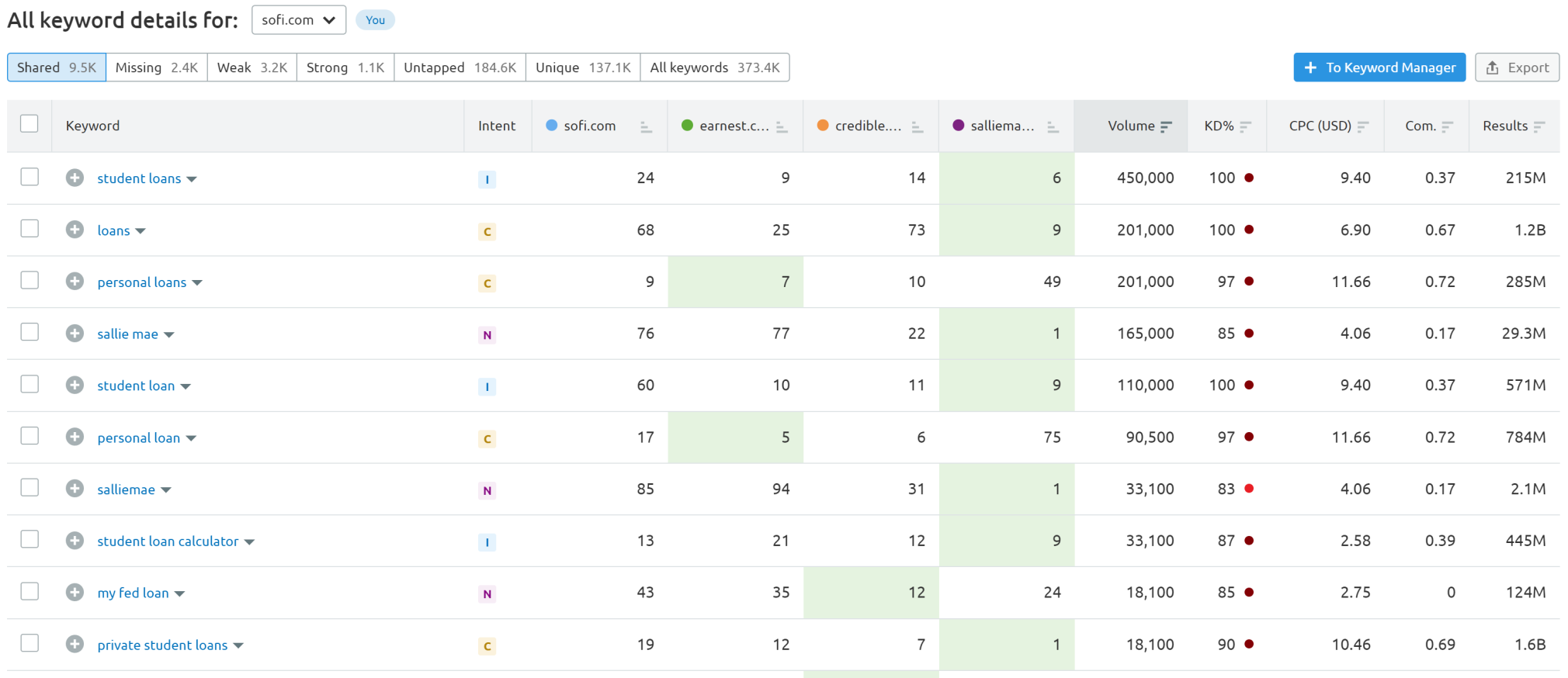
See the filters at the top of the grid?
These can help you to find keywords gaps in conjunction with the table headings.
‘Missing‘ lets you see the keywords that all of your competitors rank for, but that you don’t, whereas ‘Untapped‘ shows keywords that at least one of the other’s ranks for.
The recommendation here is to filter either by ‘volume’ or ‘KD%’ (keyword difficulty) depending on whether you have sufficient site authority to compete for high-volume search queries. If you’re a new site, as an example, you may want to target lower KD% search terms.
You can use these keyword gaps to inform your content strategy and help you to create content that competitors are ranking with but that you don’t currently have in place.
3. Use Digital PR To Earn Authority Backlinks
One of the biggest challenges that SEOs face is how to earn authority backlinks at scale.
Backlinks remain one of Google’s top ranking factors, and while there are many different link building strategies that can help you to successfully earn relevant links, the fact remains that many tactics are difficult to scale effectively.
When we look at Google’s link schemes guidelines, the recommendations are clear:
The best way to get other sites to create high-quality, relevant links to yours is to create unique, relevant content that can naturally gain popularity in the Internet community. Creating good content pays off: Links are usually editorial votes given by choice, and the more useful content you have, the greater the chances someone else will find that content valuable to their readers and link to it.
And one tactic that can help you to earn editorially placed links through the creation of awesome content is digital PR.
Think of this as creating and promoting content to journalists and publishers that they’ll want to cover and link to from within their articles. Content such as:
- Infographics
- Research studies
- Tools and calculators
- Expert insights
But really, it’s all about thinking like a PR and executing like an SEO. Digital PR isn’t about pitching out promotional pieces with a press release, rather promoting linkable assets with a solid outreach strategy. The real appeal here is that the right story can deliver significant numbers of editorially earned links from publications where your next customer could be hanging out online.
Digital PR brings benefits beyond just links, including:
- Driving referral traffic
- Creating social engagement
- Increasing brand awareness
- Putting you in front of your customers when they’re consuming content online
- Generating sales
Here’s a great guide to help you to learn more.
4. Improve Your Organic CTR Using PPC Testing
CTR is used as a ranking factor and it’s something that you should be optimizing for. But let’s break down the elements that can impact your site’s click-through rate. Typically, these are:
- Title tag
- Meta description
At least, these are the ones that you have a fair amount of control over (bearing in mind that additional ad space, image blocks, and the like can all push down organic listings and result in a lower CTR). But how do you know what title tag or meta description will deliver the highest CTR?
That’s right; you test it!
While you could do this over a longer period of time by making changes and measuring the results, other variables could come into play. If you don’t want to wait too long for results, you can leverage PPC to test these title tags and meta descriptions.
Even if you’re not running a PPC campaign as a business, it’s worth loading in a budget and setting up ads for a set of pages to test different titles and descriptions. You’re not going to get like-for-like title tags and meta descriptions with ads due to the way ad headlines and descriptions are structured, but you’ll get some powerful data around key phrases and headings, as an example.
Just be sure to properly set up your test to determine what’s having the biggest impact on CTR.
- To determine the best title tag to use, test at least three different headlines but keep the description the same for each.
- To determine the best description to use, test at least three different ones but keep the title/headline the same for each.
So long as you receive sufficient clicks on your ads, you’ll be able to rewrite your title tags and meta descriptions using this performance data and improve your organic CTR.
5. Optimize For ‘People Also Ask’
The SERPs in 2022 go way beyond the ’10 blue links’ that once occupied Google’s first page, and smart SEOs need to be tweaking their techniques and strategies to take advantage of as many SERP features as possible.
One of these features that SEOs need to utilize is ‘People Also Ask’ (PAA). If you’re not familiar with PAA, it’s the questions that show on the SERPs, like below
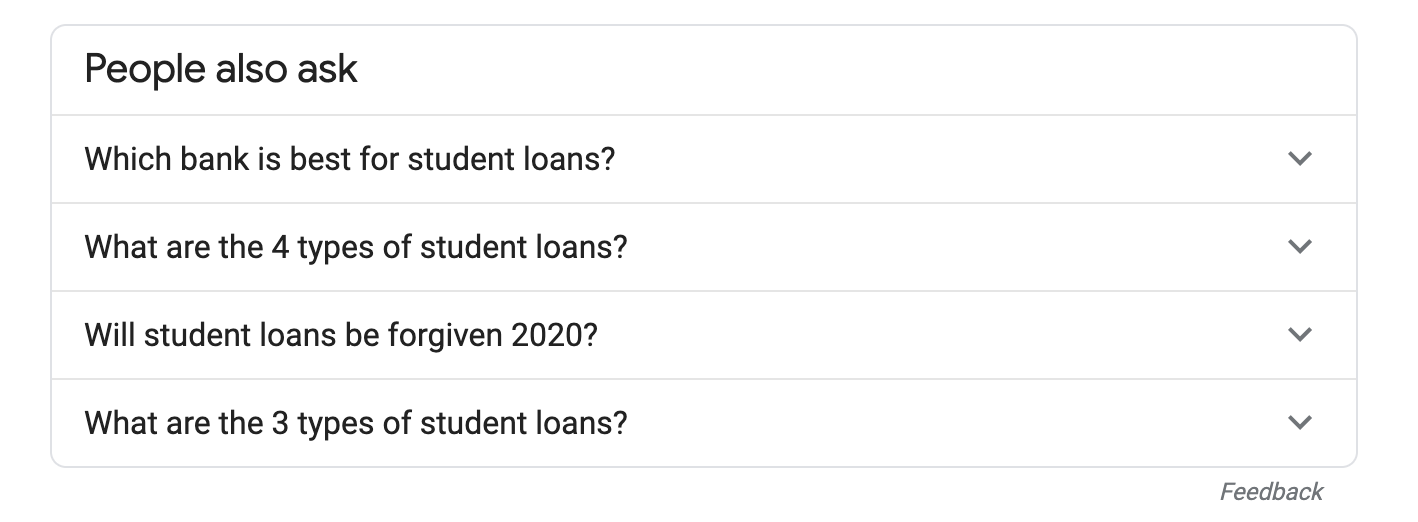
According to Semrush Sensor, the average percentage of SERPs with PAA has grown to about 40-42% for both desktop and mobile. But there are a whole host of reasons why you should be paying attention to PAA, including:
- They can help you to rank twice on page 1, with it being possible to hold a PAA result and first page ranking, unlike with featured snippets.
- They can help you to appear prominently at the top of the SERPs as an answer to the questions your customers are asking, with over 75% of PAA results showing in the top three results.
- They can be triggered as query refinements for the kinds of questions that Google might struggle to interpret.
Many marketers aren’t paying attention to PAA right now, but this means it’s an opportunity for you to gain a competitive advantage.
To learn how to take advantage of these opportunities for your website, read our study on How to Maximize ‘People Also Ask’ SEO Opportunities.
In general, though, the top-level approach to winning this feature is:
- Get an overview of existing SERP features for your target keywords with the Semrush Position Tracking tool and filter by PAA to understand your opportunities.
- Find any missed opportunities using the Organic Research tool to see queries you already rank for but don’t generate PAA results.
- Gather ideas for creating content that specifically targets PAA results with the Keyword Overview tool.
- Ensure that your page’s copy addresses a specific user query from an SEO standpoint using the SEMrush SEO Writing Assistant.
6. Steal Your Competitor’s Broken Backlinks
We’ve already discussed how difficult it can be to build quality backlinks, but one great tactic you can use is a variant of broken link building.
While this tactic is typically based on finding broken links, creating content that fits the link, and reaching out to try and get it repointed to your piece (rather than the one that’s dead), there’s a spin on it that you can use to get a head start: finding the links that point to 404 pages on your competitors’ websites.
Enter your competitor’s domain into the Semrush Backlink Analytics tool, head to the ‘Indexed Pages’ tab, and tick the ‘Broken Pages’ box.
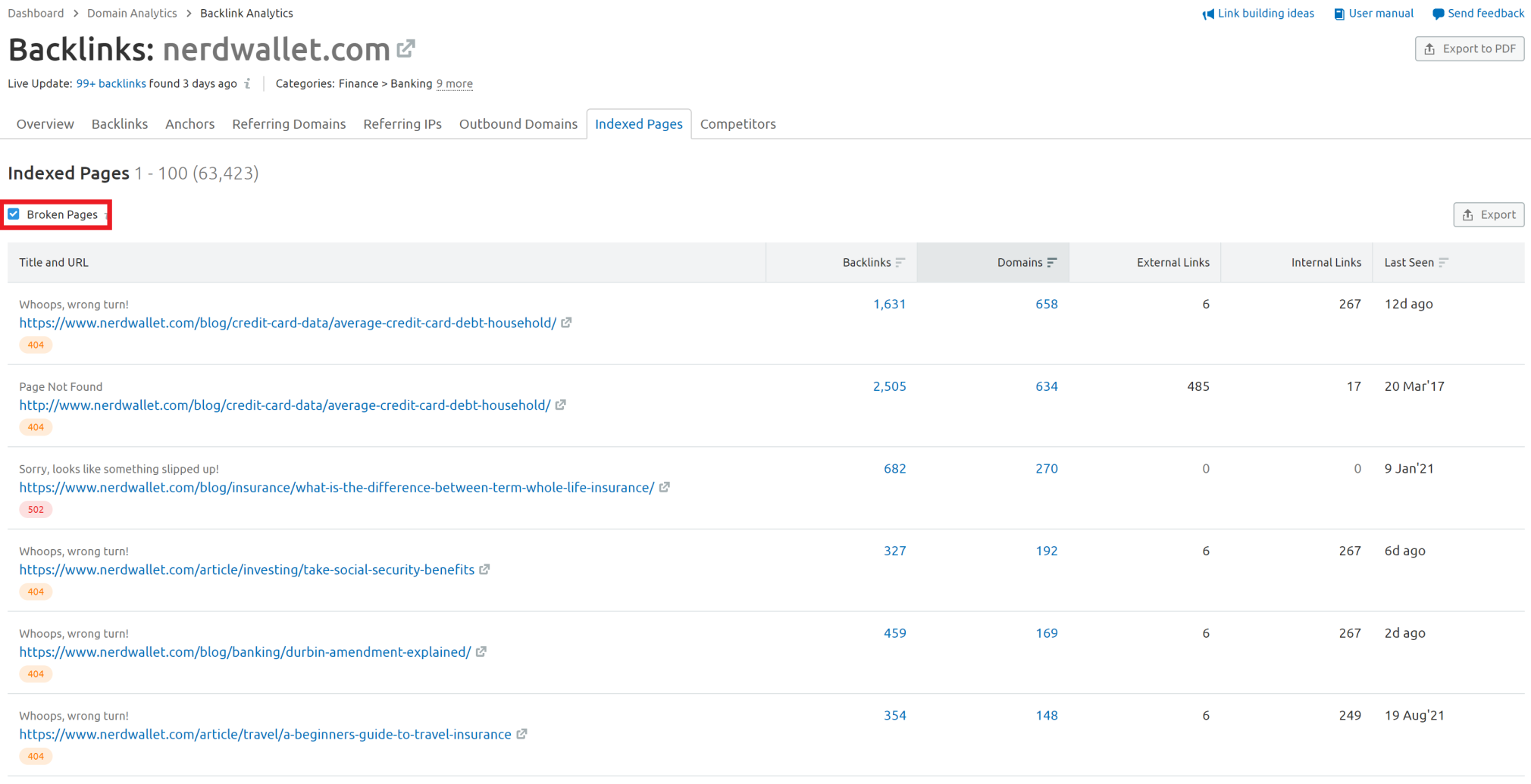
These are pages that return a 4XX error and, therefore, aren’t acquiring PageRank through the links that point to them.
Sort this by ‘Domains’, and you’ll see the number of referring domains that are linking to this specific page. It makes sense to start with this metric given that unique referring domains are one of the better measures of link building success.
Let’s look at the top example on this list. Open up the link, and we can clearly see that this is a 404
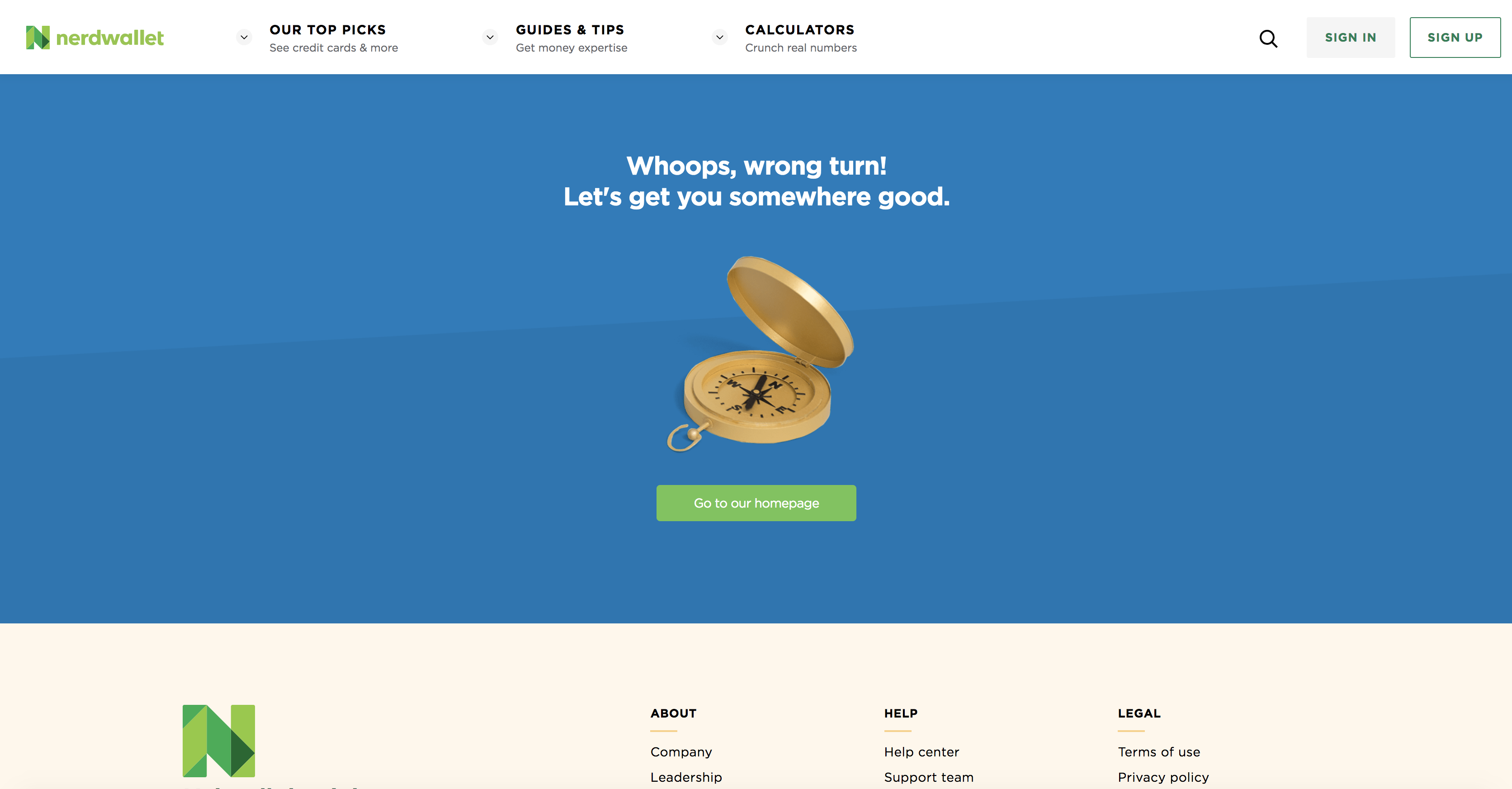
Click into the link on the tool, which will open up the specific insights for this URL. Click on the ‘Backlinks’ tab and filter by ‘Follow’ links.
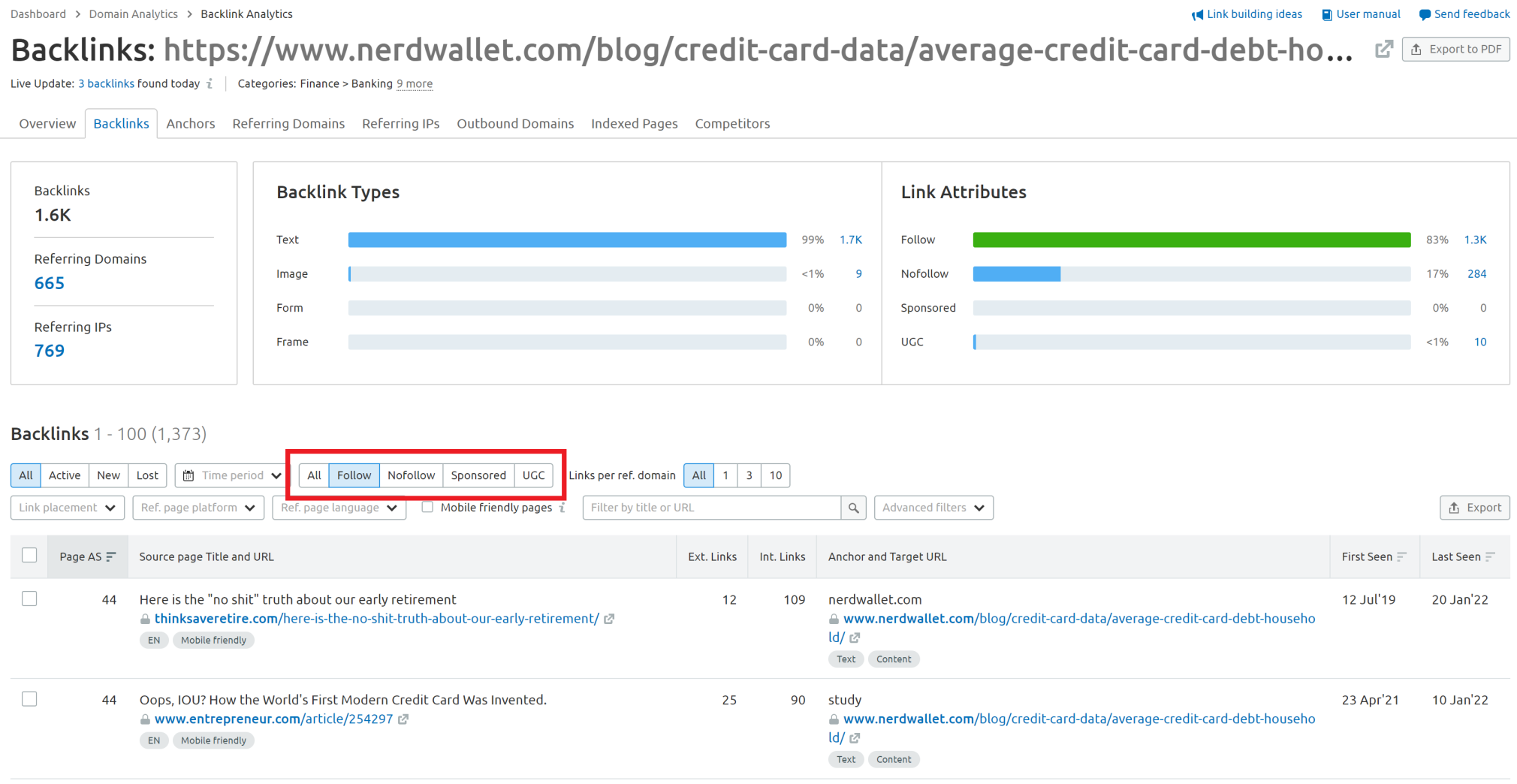
These are opportunities to reach out and suggest similar content of yours (you might need to create this) that could replace the broken link.
7. Use Supporting Content To Show Topical Expertise
Google wants to rank the best result for any given search query, and that’s why it’s so important for you to think about optimizing for topics, not just single keywords.
You need to be demonstrating topical expertise to stand a chance of ranking at the top of the SERPs for your main ‘money’ keywords, and this means getting to grips with the concept of supporting content. Familiar with topic clusters?
Essentially, this is the process of creating cluster content that’s internally linked back to a pillar page. These are more in-depth pages that answer a specific question about your broad topic and link back to the main pillar page. This strategy allows you to also create content that’s optimized for long-tail keywords.
Just think of supporting content as pieces that add topical depth to your site and demonstrate to Google (and users) that you’re an expert in your field. However, it’s important to remember that this content doesn’t always need to be created based on insights from keyword research.
In fact, publishing content around new breaking trends or subtopics is just as important as it is to be writing opinion pieces that can gain traction on social or other channels.
Supporting content, on its own, might not drive thousands of hits from organic search each month, but it can help your main pages to rank higher and earn its own traffic through other channels if promoted properly. Additionally, it can help your overall blog SEO, if you’re connecting posts to one another.
8. Use Internal Links To Supercharge Page 2 Rankings
Have you got keywords that are ranking on page 2 that need boosting onto the first page of the SERPs? Adding internal links that point to these pages could help you to achieve this.
Internal linking passes both PageRank (link authority) and relevancy signals. Internal linking is a massively underutilized SEO technique, and it’s often enough to see these page 2 rankings jump onto page 1.
To take advantage of internal linking, you first need to find opportunities to boost page 2 positions.
Enter your domain into the Semrush Organic Research tool and click the ‘Positions’ tab.
From the ‘Positions’ filter, choose #11-20. This then gives you a list of those search queries ranking on page 2 that could benefit from an internal linking boost.
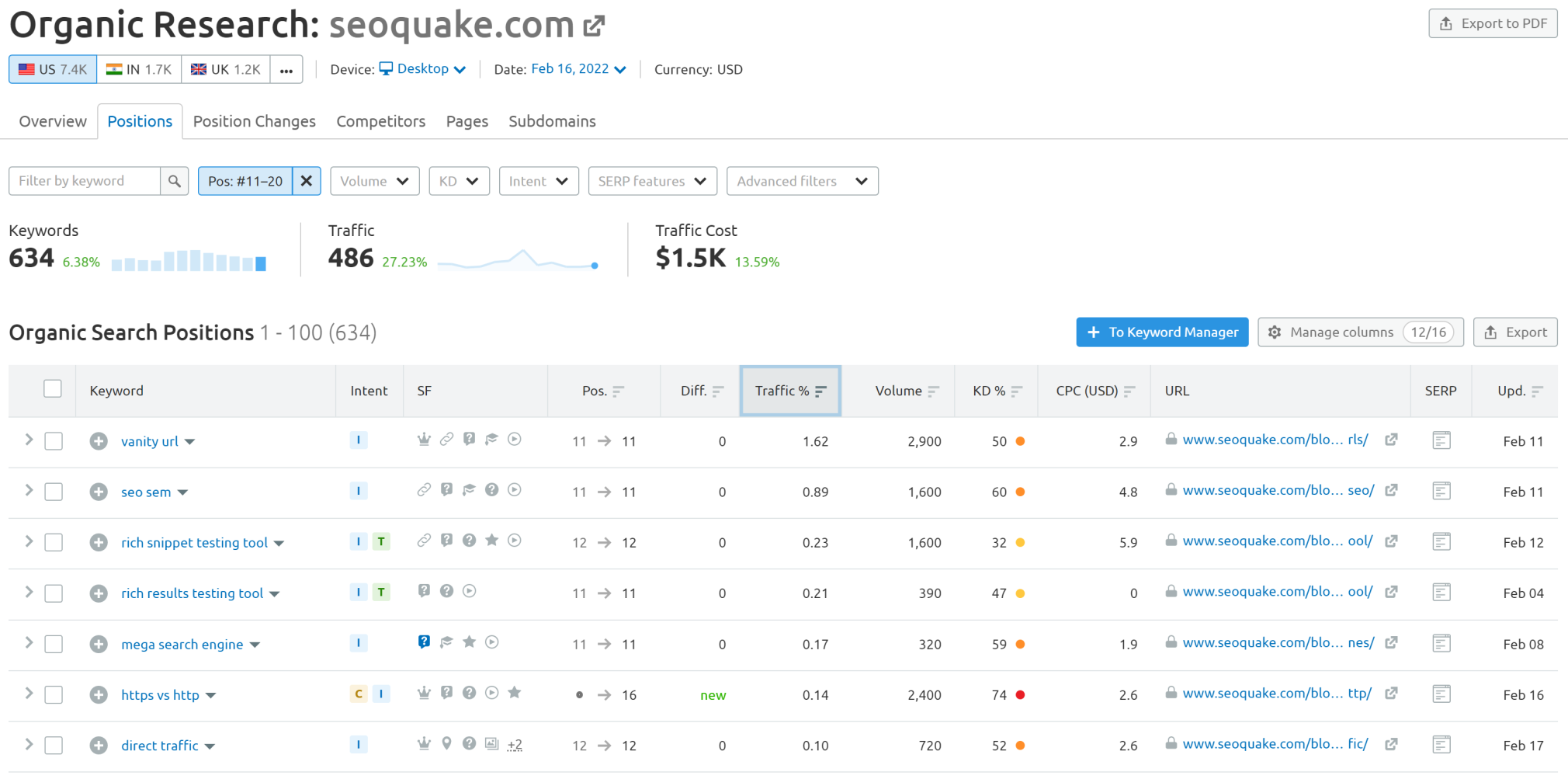
The top opportunity that we see here is a position #11 ranking for ‘vanity url.’
Let’s use this as an example.
We want to primarily pass link authority, so let’s look at the insights from the Backlink Analytics tool for the domain. Click on the ‘Indexed Pages’ tab and sort by referring domains.
Here, we’re looking to find relevant pages that have been linked to by other websites.
The SEOquake homepage has been linked to by 2.6k unique domains:

Surprisingly, the content on the page doesn’t link through to the page that ranks for ‘vanity url.’ This is a missed opportunity.
Work through your site’s top linked pages and add in internal links where possible. And don’t overlook other opportunities, either.
For instance, head to Google and run a “site:” search for your domain and target keyword.
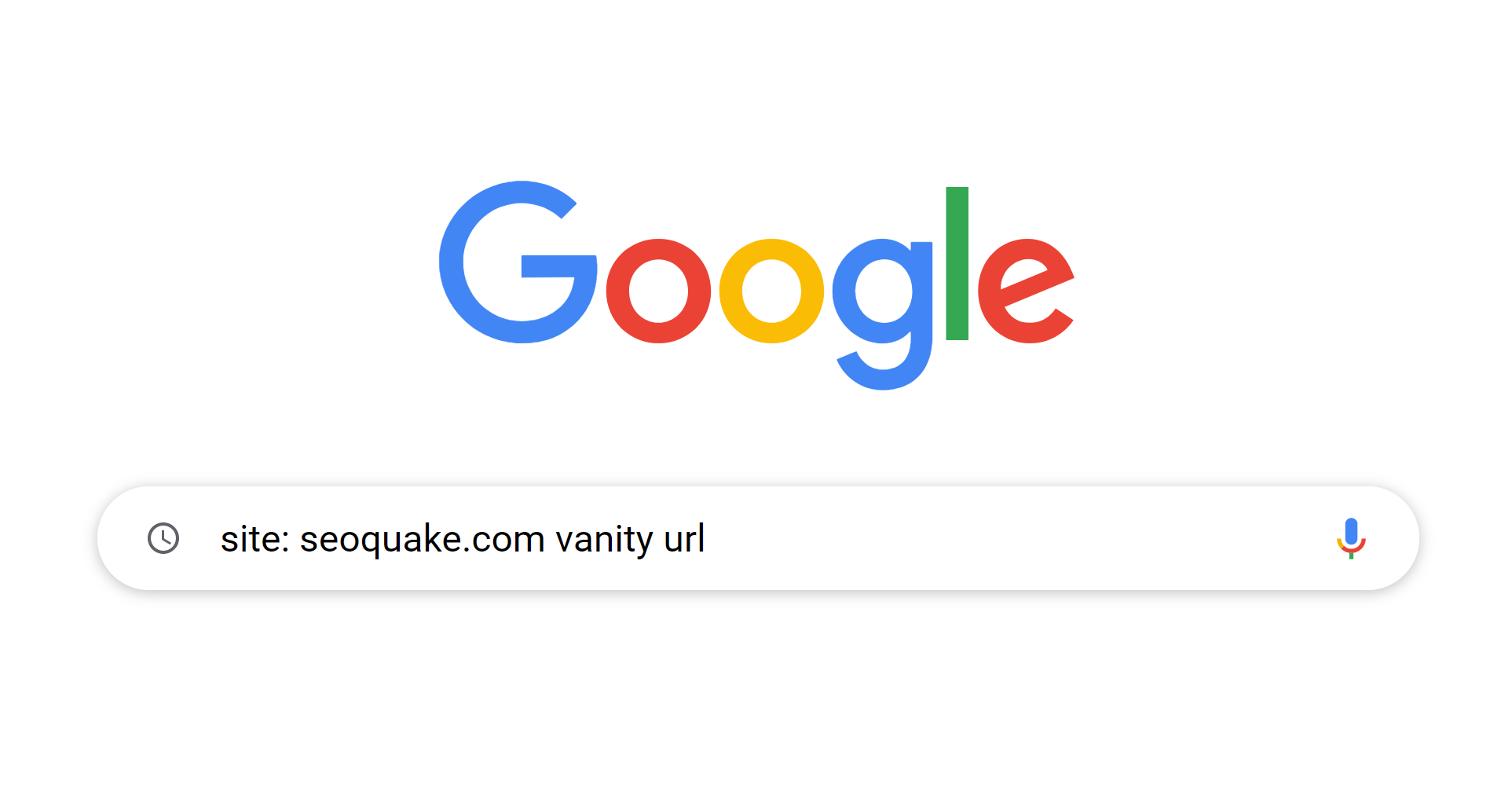
These are the pages that Google deems relevant to the query. Work through these, and if any don’t internally link, be sure to add one in.

9. Optimize for Core Web Vitals
In 2021, Google began placing more emphasis on page and user experience as ranking factors. As a result, the focus has shifted on several on-page UX elements, such as:
- Mobile-friendliness
- Safe-browsing
- HTTPS
- Intrusive interstitials
Perhaps the biggest change, though, has been the introduction of Core Web Vitals, which became a ranking signal in August 2021.
Core Web Vitals are a collection of metrics around speed, responsiveness, and visual stability, defined as:
- Largest Contentful Paint (LCP): The time that it takes for the main content of a page to load. Ideally, this will be 2.5 seconds or faster.
- First Input Delay (FID): The time it takes for a page to become interactive, ideally being less than 100 milliseconds.
- Cumulative Layout Shift (CLS): The amount of layout shift of visual page content that is unexpected, with this ideally being less than 0.1.
Core Web Vitals are the subset of Web Vitals that apply to all web pages, should be measured by all site owners, and will be surfaced across all Google tools. Each of the Core Web Vitals represents a distinct facet of the user experience, is measurable in the field, and reflects the real-world experience of a critical user-centric outcome.
You can audit the performance of your Core Web Vitals quickly and easily in Site Audit, as well as receive recommendations on how to improve them.
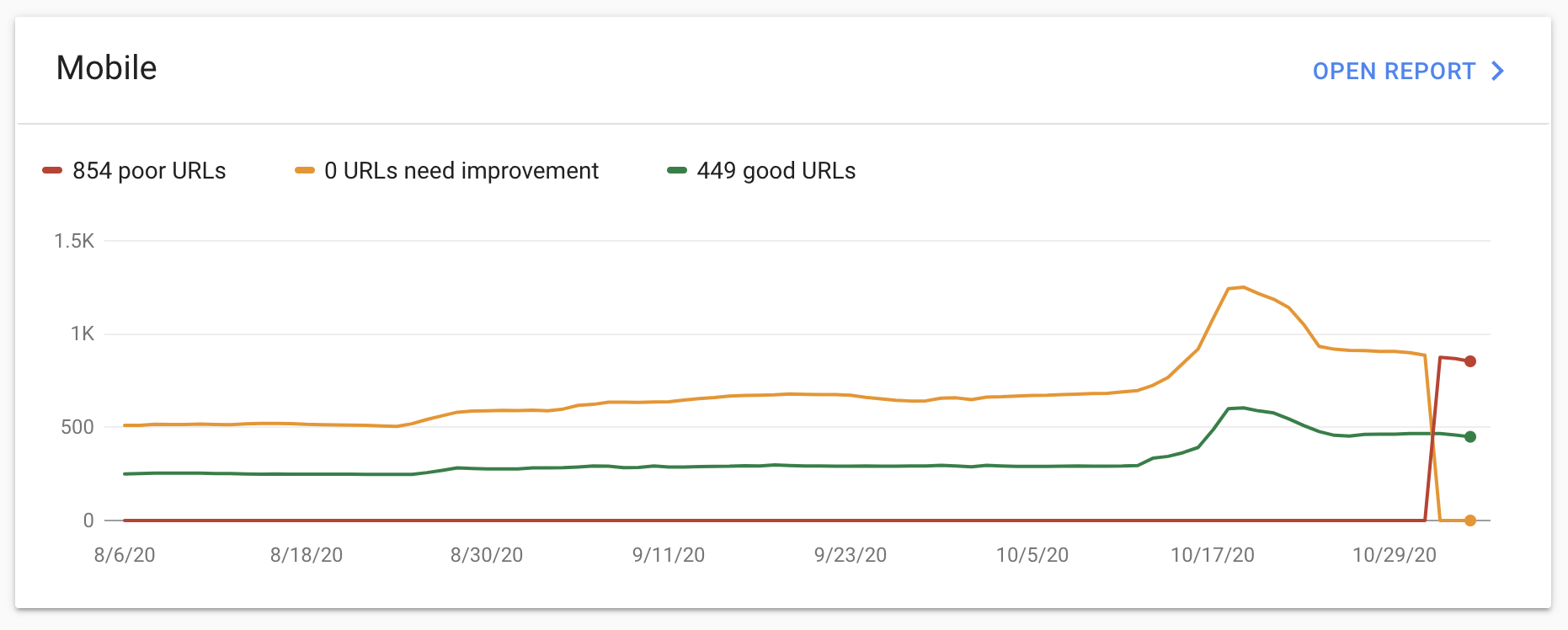
In the meantime, to learn more about Core Web Vitals, check out our dedicated webinar, or deep dive into Glen Gabe’s in-depth guide on page experience signals.

10. Make Your PR Team’s Efforts Work Harder For SEO and Turn Brand Mentions Into Links
Most businesses find themselves mentioned in the online press from time to time, even if they’re not actively working on a PR strategy.
When you do have a PR team working on promoting your business, there’s almost always an opportunity to make these efforts work harder from an SEO perspective. Unfortunately, not all press coverage will link to your website. Sometimes, you’ll only be mentioned.
While this will almost certainly satisfy a PR expert’s goals, SEOs understand the power of editorially earned links. So, let’s look at why brand mentions often get used by journalists rather than links:
- There’s simply nothing linkable (an asset that adds value when linked to)
- The (time-pushed) journalist hasn’t linked out
It’s definitely possible to turn brand mentions into links; you just need to focus your efforts on persuading a publication that your link adds value.
So, where do you start?
You can find brand mentions using the Semrush Brand Monitoring Tool. Set up your domain, and you’ll be able to see all of the mentions of your brand that have been found online. Where this gets really useful, however, is when you filter to show mentions with no links to your website.

This will then show you all of the mentions that don’t link to your site. Think of these as opportunities to reach out and turn them into a link.

You can add these links directly to the Semrush Link Building Tool, from where you can send outreach emails and monitor progress. To learn more about turning brand mentions into links, check out this Weekly Wisdom from Ross Tavendale:

11. Optimize For Image Search
If you’re not optimizing for image search, there’s an excellent chance that you’re missing out on opportunities to grab traffic from a source that your competitors probably aren’t considering. Let’s not also forget that visual search is a big deal.
While many would think of image SEO as tagging your images with alt tags, it goes way beyond this. If properly optimize your site’s images, you stand a real chance of being able to rank prominently on the image SERPs.
So, where do you start?
Reading our guide to image SEO will help you to dive deep into the SEO techniques that you should be using to optimize your site’s images, but in short, you need to be considering:
- Alt tags
- File names
- Resizing images to the needed dimensions
- Reducing file sizes
- Creating an image sitemap
- Hosting your images on a CDN
While going back and optimizing existing images might take some time, creating a process for adding and uploading future images to your site ensures that these boxes will be ticked from the start.
12. Clean Up Toxic Links
Just as backlinks can help your website rank higher on Google, the wrong type of links can also harm your rankings.
If we look at Google’s Link Schemes guide, we can see their stance on links deemed to be unnatural or toxic:
Any links intended to manipulate PageRank or a site’s ranking in Google search results may be considered part of a link scheme and a violation of Google’s Webmaster Guidelines. This includes any behavior that manipulates links to your site or outgoing links from your site.
At best, these links will be ignored. At worst, they could harm your rankings.
If your site has toxic links in its link profile, it’s recommended that you take the time to clean them up. But let’s look at some of the reasons why your site may have toxic links in the first place:
- Links that have been bought (or received in exchange for gifted products)
- Link building using exact match anchor text
- Large-scale article marketing or guest posting campaigns
- Negative SEO
- Low-quality directory or bookmark site tactics
You can find toxic links using the Semrush Backlink Audit Tool.
Set up your domain in the tool, and you’ll see an insight into the potential toxicity of your link profile, including a clear breakdown of how your link profile breaks down in terms of risk.

From here, you can review the links deemed to be toxic and either add those you know are natural to a whitelist or move to your ‘remove list’ to reach out and send backlink removal requests to domain owners. The tool will automatically provide you with contact details for the site.
Want to learn more about auditing your link profile and removing toxic backlinks? Take a look at our guide on Backlink Analysis: How to Spot Quality and Toxic Backlinks.
If you want to continue to see your site’s organic traffic increase, you need to move beyond the basics and dive deep into SEO techniques that will take your site to the next level.
Take the time to go beyond the basics and look for opportunities that your competitors aren’t taking advantage of, implement a strategy, and watch your site succeed.

